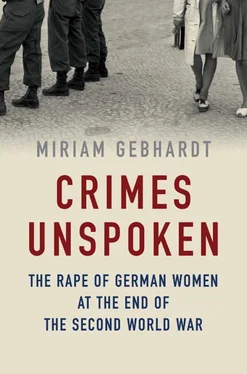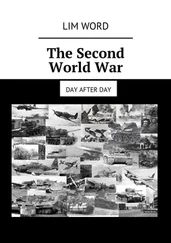But even she didn’t escape the rapists. After the first two assaults, she went to the commandant and complained. Then she describes very precisely how she tried to dissociate herself from what she had experienced: ‘My true self simply leaving my body behind, my poor, besmirched, abused body. Breaking away and floating off, unblemished, into the white beyond. It can’t be me this is happening to.’ [50] Ibid.
In this way she appeared to relativize the rapes: ‘It sounds like the absolute worst, the end of everything – but it’s not.’ The next time she would close her eyes and clench her teeth. It was only when one of the perpetrators dropped a gob of spit into her mouth that she sank to the ground in disgust. [51] Ibid.
It was then that she decided: ‘I have to find a single wolf to keep away the pack. An officer, as high-ranking as possible, a commandant, a general, whatever I can manage. After all, what are my brains for, my little knowledge of the enemy’s language?’ Now she felt better because she was doing and planning something and was no longer a silent prey but had tamed one of the wolves, ‘the strongest in the pack’. [52] Ibid.
Her image of Russians is coloured by contemporary stereotypes: the Red Army soldiers were either round-headed peasants, childlike, uncivilized, fond of schnapps, occasionally also goodhearted and easy to manipulate, or highly educated, musical, melancholy aristocrats. The image ‘Anonymous’ has of herself is one of an anti-bourgeois woman dating from the 1920s that was cultivated during the Nazi era and lived on in the 1950s. She was sensible, pragmatic, opportunistic, concerned only with what was most important, vital and always looking to manage her life – in the spirit of ‘what doesn’t kill me makes me stronger’. [53] Ibid.
After having passed through various hands, ‘Anonymous’ ultimately ends up with a major, who feeds and protects her and is comparatively friendly because he is interested not only in sex but in female conversation. She wonders to herself (and to the reader) if she should feel like a prostitute, but she pushes her scruples aside, arguing that it is a matter of survival. At some point, she even sees herself as an emancipated woman: ‘A German man always wants to be smarter, always wants to be in a position to teach his little woman. But that’s something Soviet men don’t know about – the idea of the little woman tending her cosy home.’ [54] Ibid.
It is true that, even today, this is an ambivalent book, with its stereotypical Russians, the unshakeable national pride and claim to superiority, its Darwinian worldview, the rustic female ideal. It is hardly surprising that it was unpopular in the 1950s, when people sought salvation in the bourgeois pre-war idea of the family. Added to this was the frank discussion of sex. ‘Anonymous’ spoke of the limited sexual expertise of the Red Army soldiers (‘when it comes to matters erotic they’re still with Adam and Eve’), [55] Ibid.
but also about her own sexuality, how she had been earlier, how she had become frigid through all the forced intercourse, how she also developed warm feelings for her ‘Russian’ and was sad when her protector was sent back to the Soviet Union.
A Woman in Berlin goes through all the shades of grey, from the most brutal sexual assault to calculated sex as a favour, prostitution and consensual sex; it deals with venereal diseases and abortion and ultimately the hurt pride of the returning men who don’t allow the women’s fate to touch them: ‘You’ve all turned into a bunch of shameless bitches, every one of you in the building. Don’t you realize that?’ asks Gerd, the morally superior soldier returning from the front, of the ‘immoral’ Berlin survivor. [56] Ibid.
This is what ‘Anonymous’ and the other rape victims could expect as the attitude to their experiences in the 1950s: a depressing climate in which the woman suffers in silence for the sake of her family and marriage.
But what about the reproach that the diary is a dubious historical source, as Jens Bisky states in his review of the book? ‘Anonymous’ initially jotted down notes on events between 20 April and 22 June 1945 in school exercise books. After the war she typed them up and gave them to her friend, the popular author C. W. Ceram, who arranged for their publication. The first edition in English in 1954 was followed by further translations until finally, in 1959, a small publisher in Geneva published the book in German.
Jens Bisky complained that the various stages in the development of the text of the reissue, which was published in 2003 as part of Hans Magnus Enzenberger’s ‘Andere Bibliothek’, had not been made sufficiently transparent, and it was for that reason that the book was ‘worthless as a historical document’ and was indication only of the efforts by the publisher, whose true motive was to present a distorted picture of the Communists. A Woman in Berlin was not a historical document, he said, and it was possible that the author didn’t even exist. [57] Bisky, ‘Wenn Jungen Weltgeschichte spielen’.
When Bisky followed up his suspicion with detective zeal, he discovered a journalist born in 1911 in Bielefeld. She had initially flirted with Communism, had then become a member of the youth section of the National Socialist Women’s League and worked ‘as a minor advocate of the Third Reich’ by writing about spun rayon, the navy and the Reich autobahn. Bisky speculates about her attitude to Nazism: ‘Like most people she will have found fault here and there, but will have welcomed the activism, modernity and sense of belonging.’ [58] Ibid.
Bisky refused to accept the diary as a historical source and saw it rather as a literary work of non-fiction in which it is impossible to know what was written by the author and what by others. It is quite possible, he says, that it was Ceram who turned the manuscript into a book. An objective appraisal was not possible, which also meant that what the author wrote about her experience of mass rape in Berlin could well be completely fictional.
Bisky is right to examine the text and question how it was written, but his implicit assumption that a historically authentic diary can ever be beyond suspicion as a historical source is illogical. Diaries are always subject to a whole series of editing and publication processes and are never a true reflection of the historical reality. [59] For a detailed discussion of Bisky’s reservations, see also Constanze Jaiser, review of Anonyma – Eine Frau in Berlin, Tagesbuchaufzeichnungen vom 20. April bis 22. Juni 1945 (Frankfurt 2003), in: H-Soz-u-Kult , 5 December 2003, http://hsozkult.geschichte.hu-berlin.de/rezensionen/2003–4–128 .
The well-known diaries on the mass rape in Berlin that are repeatedly used as a basis for a historical reconstruction of the events, for example the book by ‘Anonymous’ but also Margret Boveri’s Tage des Überlebens , have been revised several times and adapted for publication. Even if the diaries or reminiscences were not necessarily written on behalf of an exiles’ association or other interest groups, there were many other reasons for their publication that went beyond direct narration towards an attempt to cope with what had happened. Diaries and similar notebooks served for crisis management, and are indeed the crisis genre per se. They address the enforced silence and offer the possibility of confronting the shocks to personal identity. They are always aimed at least at one person – in the case of raped women often their own husbands – to whom the writer opens herself. The writing involves self-justification, reflection on the future, and also adaptation of the experience to socially accepted standards. Typical motives include elevating the individual testimony into an event of ‘world historical import’ or advancing the notion of having made a personal ‘sacrifice for Germany’. [60] Susanne zur Nieden, Alltag im Ausnahmezustand: Frauentagebücher im zerstörten Deutschland 1943 bis 1945 (Berlin 1993). A number of works have been published on research into personal testimony, including by the author; see, for example, ‘Der Fall Clara Geissmar, oder von der Verführungskunst weiblicher Autobiographik’, in: Kirsten Heinsohn and Stefanie Schüler-Springorum (eds.), Deutsch-jüdische Geschichte als Geschlechtergeschichte: Studien zum 19. und 20. Jahrhundert (Göttingen 2006), pp. 233–49; more generally, Dagmar Günther, ‘And now for something completely different: prolegomena zur Autobiographie als Quelle der Geschichtswissenschaft’, in: Historische Zeitschrift , 272 (2001), pp. 25–61.
Читать дальше











